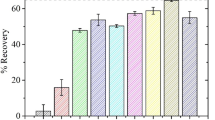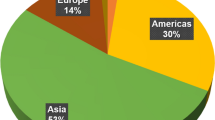Abstract
The present study deals with the use of low-cost plant-derived materials, namely a biochar, spent coffee grounds, spent tea leaves, and a compost humic acid, for the adsorptive removal from water of two estrogens, 4-tert-octylphenol (OP) and 17-β-estradiol (E2), and two pesticides, carbaryl and fenuron, each spiked at a concentration of 1 mg L−1. Kinetics and adsorption isotherms have been performed using a batch equilibrium method to measure the sorption capacities of the adsorbents towards the four molecules. Adsorption constants were calculated using the linear, Freundlich, and Langmuir models. Kinetics data obtained evidenced a rapid adsorption of each compound onto both biochar and coffee grounds with the attainment of a steady-state equilibrium in less than 4 h. Significant differences among the adsorbents and the compounds were found regarding the model and the extent of adsorption. In general, the estrogens were adsorbed more quickly and in greater amounts than the less hydrophobic pesticides, following the order: OP > E2 > carbaryl > fenuron. The ranges of Freundlich constants obtained for OP, E2, carbaryl, and fenuron onto the sorbents were 5049–2253, 3385–206, 2491–79, and 822–24 L kg−1, respectively. The maximum values of constants were obtained for biochar, except for OP that was more adsorbed by spent coffee grounds. Adsorption kinetic data followed a pseudo-second-order model, thus indicating the occurrence of chemical interactions between the compounds and the substrates. The remarkable sorption capacities of all adsorbents towards the four molecules suggest the valuable exploitation of these materials for decontamination purposes, such as the treatment of wastewater before a feasible recycle in soil.



Similar content being viewed by others
References
Ahel M, Giger W, Koch M (1994) Behavior of alkylphenol polyethoxylate surfactants in the aquatic environment 1. Occurrence and transformation in sewage treatment. Water Res 8:1131–1142
Ahmaruzzaman M (2008) Adsorption of phenolic compounds on low-cost adsorbents: a review. Adv Colloid Interf Sci 143:48–67
Ali I (2012) New generation adsorbents for water treatment. Chem Rev 112:5073–5091
Ali I (2014) Water treatment by adsorption columns: evaluation at ground level. Sep Purif Rev 43:175–205
Ali I, Asim M, Tabrez AK (2012) Low cost adsorbents for the removal of organic pollutants from wastewater. J Environ Manag 113:170–183
Ali I, Gupta VK (2007) Advances in water treatment by adsorption technology. Nat Protoc 1:2661–2667
Baronti C, Curini R, D’Ascenzo G et al (2000) Monitoring natural and synthetic estrogens at activated sludge sewage treatment plants and in a Receiving River water. Environ Sci Technol 34:5059–5066
Braden JB, Shortle JS (2013) Agricultural sources of water pollution. In: Shogren JF (ed) Encyclopedia of energy, natural resource, and environmental economics. Elsevier, Waltham, pp 81–85
Franca AS, Oliveira LS, Ferreira ME (2009) Kinetics and equilibrium studies of methylene blue adsorption by spent coffee grounds. Desalination 249:267–272
Gupta VK, Carrott PJM, Ribeiro Carrott MML, Suhas (2009) Low-cost adsorbents: growing approach to wastewater treatment—a review. Crit Rev Environ Sci Technol 39:783–842
Gupta VK, Suhas (2009) Application of low-cost adsorbents for dye removal – a review. J Environ Manag 90:2313–2342
Hameed BH (2009) Spent tea leaves: a new non-conventional and low-cost adsorbent for removal of basic dye from aqueous solutions. J Hazard Mater 161:753–759
Hansch C, Leo A, Hoekman D (1995) Exploring QSAR: hydrophobic, electronic, and steric constants. American Chemical Society, Washington, DC, USA
Hernández AF, Parrón T, Tsatsakis AM, Requena M, Alarcón R, López-Guarnido O (2013) Toxic effects of pesticide mixtures at a molecular level: their relevance to human health. Toxicology 307:136–145
Ho YS, McKay G (1999) Pseudo-second order model for sorption processes. Process Biochem 34:451–465
Idowu AA, Sunday O, Olateju KS (2016) Removal of Mn(II) from aqueous solution by Irvingia gabonensis immobilized Aspergillus sp. TU-GM14: isothermal, kinetics and thermodynamic studies. J Environ Biotechnol Res 3:1–11
Jiang L-h, Liu Y-g, Zeng G-m, Xiao F-y, Hu X-j et al (2016) Removal of 17β-estradiol by few-layered graphene oxide nanosheets from aqueous solutions: external influence and adsorption mechanism. Chem Eng J 284:93–102
Loffredo E, Senesi N (2006a) The role of humic substances in the fate of anthropogenic organic pollutants in soil with emphasis on endocrine disruptor compounds. In: Twardowska HE, Allen MM, Häggblom S, Stefaniak I (eds) Viable methods of soil and water pollution monitoring, protection and remediation, NATO sciences series, Vol 69. Springer, NL, pp 69–92
Loffredo E, Senesi N (2006b) Fate of anthropogenic organic pollutants in soils with emphasis on adsorption/desorption processes of endocrine disruptor compounds. Pure Appl Chem 78:947–961
Loffredo E, Traversa A, Gattullo CE (2012) Benefits from compost use in the preparation of growing substrates for plants in container: inhibition of Sclerotinia sclerotiorum and protection of philodendron. Fresenius Environ Bullet 21:2208–2214
Oladipo AA, Abureesh MA, Gaz M (2016) Bifunctional composite from spent “Cyprus coffee” for tetracycline removal and phenol degradation: solar-Fenton process and artificial neural network. Int J Biol Macromol 90:89–99
Rossner A, Snyder SA, Knappe DRU (2009) Removal of emerging contaminants of concern by alternative adsorbents. Water Res 43:3787–3796
Schnitzer M (1982) Organic matter characterization. In: Page BL et al (eds) Methods of soil analysis, part 2, chemical and microbiological properties, 2nd edn agronomy monograph 9 SSSA, Madison, WI, pp 581–594
Senesi N, Loffredo E (2001) Soil humic substances. In: Hofrichter M, Steinbüchel A (eds) Biopolymers Vol 1: Lignin, Humic Substances and Coal. Wiley-VCH Verlag GmbH, Weinheim, pp 247–299
Senesi N, Loffredo E, D’Orazio V, Brunetti G, Miano TM, La Cava P (2001) Adsorption of pesticides by humic acids from organic amendments and soils. In: Clapp CE et al (eds) Humic Substances and Chemical Contaminants. Soil Sci Soc Am, Madison, WI, USA, pp 129–153
Stevenson FJ (1994) Humus chemistry: genesis, composition, reactions, 2nd edn. Wiley, New York, NY
Tan X, Liu Y, Zeng G, Wang X, Hu X, Gu Y, Yang Z (2015) Application of biochar for the removal of pollutants from aqueous solutions. Chemosphere 125:70–85
Wang D, Mukome FND, Yan D, Wang H, Kate M, Scow KM, Parikh SJ (2015) Phenylurea herbicide sorption to biochars and agricultural soil. J Environ Sci Health, Part B: Pesticides, Food Contaminants, and Agricultural Wastes 50:544–551
Ying G-G, Kookana RS, Dillon P (2003) Sorption and degradation of selected five endocrine disrupting chemicals in aquifer material. Water Res 37:3785–3791
Zhang P, Sun H, Yu L, Sun T (2013) Adsorption and catalytic hydrolysis of carbaryl and atrazine on pig manure-derived biochars: impact of structural properties of biochars. J Hazar Mater 244-245:217–224
Acknowledgments
This work was funded by University of Bari Aldo Moro, Italy.
Author information
Authors and Affiliations
Corresponding author
Additional information
Responsible editor: Philippe Garrigues
Rights and permissions
About this article
Cite this article
Loffredo, E., Taskin, E. Adsorptive removal of ascertained and suspected endocrine disruptors from aqueous solution using plant-derived materials. Environ Sci Pollut Res 24, 19159–19166 (2017). https://doi.org/10.1007/s11356-017-9595-z
Received:
Accepted:
Published:
Issue Date:
DOI: https://doi.org/10.1007/s11356-017-9595-z




